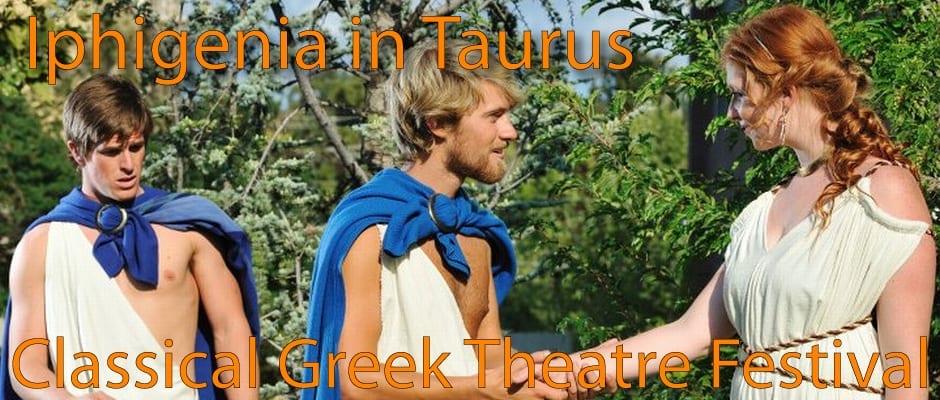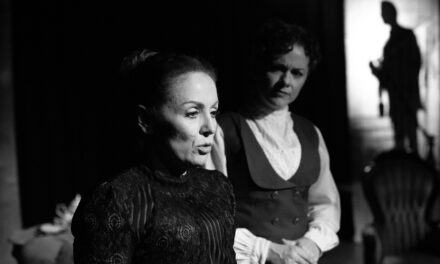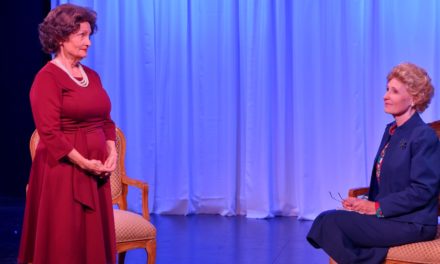SALT LAKE CITY — Of the three big names of ancient Greek theatre—Aeschylus, Sophocles, and Euripides—Euripides is the ancient Greek author with the largest surviving body of work. Probably his most famous works are the tragedies The Trojan Women and Medea. But these are just two of the nearly twenty surviving plays of Euripides. One of the lesser known works in his canon is Iphigenia in Tauris, which is this year’s production mounted by the Classical Greek Theatre Festival.
Iphigenia in Tauris is the story of Iphigenia (pronounced “if-i-jin-EYE-a”), a Greek woman who is a priestess to Artemis in a distant land called Tauris, which is ruled by the king Thaos. As part of her priestly duties, Iphigenia is required to ceremonially cleanse any Greek man who comes to the kingdom so that he can be executed. These being her countrymen, she hates her position in life and longs to return to her homeland. One day, two bound Greek men are brought to her in preparation for their execution and she discovers that one of them is her brother Orestes, whom Iphigenia had thought was dead. This leads her to conspire to escape with her brother to Greece.
Director Anne Stewart Mark has chosen to make this production as faithful as possible to the original intentions of Euripides and the original practices of ancient Greek theatre. To this end, the productions are performed outdoors when possible (although the opening performance that I attended was moved indoors because of inclement weather), and music introduced to the play. Mark has also attempted to bring some humor out of the script (a new translation from Marianne McDonald and J. Michael Walton), although some of the jokes fall flat. Ancient Greek theatrical practices also included the classic Greek chorus (on stage for almost the entire show), which did a great deal of dancing (choreographed by William Richardson).
However, in her fidelity to ancient Greek traditions, I feel that Mark has made Iphigenia in Tauris wildly inaccessible to the average 21st century American. Instead of adapting the conventions of Greek theatre to today’s audience, she has embraced them fully. This leaves the show feeling more like a museum piece than entertainment. One large contribution to the play’s inaccessibility is Ricklen Nobis’s music. Based on what little is known of ancient Greek musical practices, the songs in Iphigenia in Tauris sound stale and droning to a modern ear. Moreover, many of the songs sounds the same and they often seemed to have no distinct beginning or end. Nobis’s music was not helped by the poor diction of the actors, especially the chorus members. Because so many of the lyrics were difficult to understand, the songs often ended up sounding like an incoherent cacophony. The choreography is also unimpressive and trite; for example, when mentioning Artemis—the hunting goddess—the chorus members mimed shooting an arrow. These are the sort of actions that I would expect from a middle school production, not a university one.
The acting in this production varied in quality. Most enjoyable were Jared Thomson as the bombastic King Thaos and Ryon J. Sharette as the herdsman. However, these are comparitively small roles and its a shame that the most engaging actors in the cast were given to a relatively small amount of stage time. Both Thomson’s and Sharette’s monologues brought an energy and excitement to the play that was missing from many other scenes
On the other hand, Lexie Stuivenvolt Allen was a most uninteresting Iphigenia and she rarely seemed interested in what she had to say. I felt like her emotions were muted, such as when she finds out that the man brought to the temple is her brother Orestes. I also did not believe that Allen had the charisma and dynamism needed for a role that requires her to be the center of attention for the majority of a performance. I was also not impressed by Wyatt McNeil’s portrayal of Orestes. Despite the fact that Orestes is in some extreme situations—facing an execution, being reunited with a sister, etc.—McNeil seemed to always be on the same emotional level.
I don’t entirely blame these actors (and others) for subpar performances. This is an extremely difficult script; most of the dialogue is telegraphic and Euripides didn’t design these characters to seem like real-life people. Instead, they’re supposed to be distant and larger than life. Also, the script is incredibly wordy. Ancient Greek drama did not have “action scenes.” Rather, action occurred offstage and a character (such as the herdsman or the soldier in this play) would enter and tell the audience everything that happened elsewhere. This makes Iphigenia in Tauris feel like little more than a series of monologues and 2- and 3-person scenes.
Visually, however, I enjoyed the production. The severed heads served as a constant grisly reminder of the duties of Iphigenia. The costumes (designed by Phillip Lowe) were similar to what I would imagine stereotypical Greeks would wear, and (thankfully) didn’t feel like they came from Animal House. I also think that Spencer Brown’s set pieces—simple as they were—complemented the other technical elements and Mark’s concept rather nicely.
So, should you go to Iphigenia in Tauris? Not if you’re looking for a rollicking evening of entertainment. But the ancient Greeks represent the origin of our modern Western theatrical tradition and I think that every theatre fan should see at least one of these plays in order to understand theatre history better. Moreover, it’s highly unlikely that Iphigenia in Tauris will be performed in this state again in the near future. Overall, I think that watching Iphigenia in Tauris is much like watching PBS: educational, but often not entertaining.
- Red Butte Garden Amphitheater (300 Wakara Way, Salt Lake City), September 17-18 and 24-25 at 9 AM. Tickets are $7-15.
- Harris Fine Arts Center (on the campus of Brigham Young University, Provo), September 19 at 5 PM. Tickets are $9-11.
- Shepherd Union Wildcat Theater (on the campus of Weber State University, Ogden), September 28 at 7:30 PM. Free admission.







